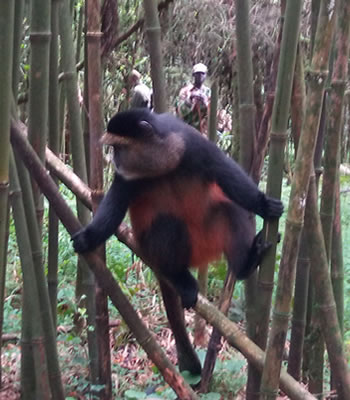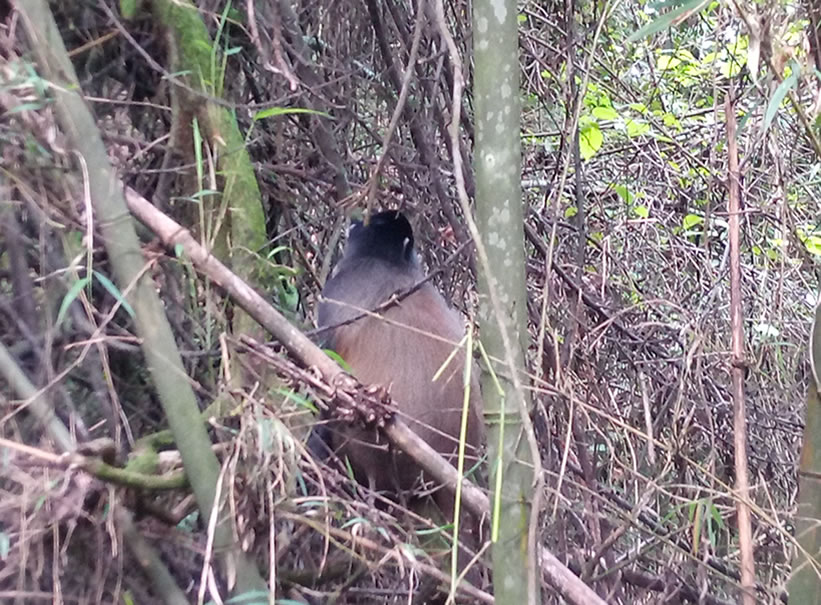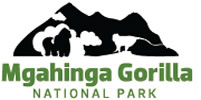Mgahinga National Park offers the chance to track the golden monkeys (Ceropithecus Kandti) sometimes referred to as a distinctive race of the more widespread blue monkey C.mitis), a little known bamboo-associated taxa primate listed as ‘endangered’ by the World Conservation Union. Endemic to the Albertine Rift, the golden monkey is characterized as a bright orange-gold body, cheeks and tail, contrasting with its black limbs, crown and tail end.
 Until a few years ago, this pretty monkey was common in Rwanda’s Gishwati Forest Reserve, most of which was chopped down by returned refugees in the aftermath of the 1994 genocide and unconfirmed sources indicate that a small population might occur further south in the same country’s Nyungwe Forest National Park. Fortunately, the golden monkey is the numerically dominant primate within this restricted range – a 2003 survey estimated a population of 3,000 – 4,000 in Mgahinga National Park.
Until a few years ago, this pretty monkey was common in Rwanda’s Gishwati Forest Reserve, most of which was chopped down by returned refugees in the aftermath of the 1994 genocide and unconfirmed sources indicate that a small population might occur further south in the same country’s Nyungwe Forest National Park. Fortunately, the golden monkey is the numerically dominant primate within this restricted range – a 2003 survey estimated a population of 3,000 – 4,000 in Mgahinga National Park.
These primates are endangered and endemic to this region, sharing their home with the world famous Mountain Gorilla, as well as buffalo, forest elephant and other species of mammals. In the beginning and for many months to follow it was very difficult to even find the monkeys owing to the fact that unlike gorillas they are small, do not make nests and leave little evidence of their presence on the forest floor, and at times can be quiet especially in the presence of their main predator the eagle. Also not been used to us they would just run away.
The group is very much used to our presence now, allowing us to have an insight into their daily lives. The monkeys dictate how the day is going to be, and no day is ever the same in the forest. We just never know how the working day is going to turn out, and this is what makes the experience so exciting. You will encounter challenges regularly. One of our biggest problems is the weather. Trekking at an altitude of around 2,500 meters you will encounter strong winds, heavy rainfall and extreme coldness, so is the best place to trek the golden monkey or gorillas though not reliable.
The weather really does make a difference to how the day is going to be. Wind makes it conducive to track the monkeys as trek the slopes, they stay quiet and in mid canopy because they have problems hearing predators and when the trees blow you do not know if it is monkey moving or wind blowing, or both. When it rains the monkeys take shelter and do not move, hence closer view of them. No matter how the weather conditions are, the forests walk every day, even public holiday is awesome. With all that, when it rains in the forest and the mist comes down among the moss and overhanging vegetation it is certainly the most beautiful place to be.
Golden Monkey Tracking Permit

For those going on a primate safari in Uganda, a golden monkey permit in Uganda costs $50 per person for foreign non residents, $40 per person for foreign residents and Shs 20,000 for East African Residents. This cost includes the park entry fee, the guide fee and the one hour yo
u spend with the golden monkeys. These permits can be booked on ground from the Park headquarters in Ntebeko Visitor Center. Tourists who wish to spend more quality time and understand the detailed information regarding the golden monkeys can visit this Park for the engaging golden monkey habituation experience that costs only $100 per person.
How is Golden Monkey Tracking Conducted
Just like gorilla trekking, golden monkey tracking starts with tourists arriving at the Park headquarters by 7:30am for pre-tracking briefing (on the dos and don’ts of tracking the golden monkeys). The actual trek begins at 8:00am. Hiking through the forests to sight the golden monkeys is not so strenuous like gorilla trekking because golden monkeys live in lower areas, so tourists do not track for more than 3 hours. When tourists encounter the golden monkey family, they are given one hour to spend with them (to take photographs and observe their behavior). With this activity, there is no minimum number of tourists who track each group and age limit is 12 years.
Safety of Golden Monkey Trekking
The safety of golden monkey trekking in Mgahinga Gorilla National Park is a top priority for both trekkers and wildlife. Led by experienced rangers, the trekking experience is designed to be secure, with strict guidelines to protect both visitors and the golden monkeys. By following the safety guidelines, visitors can enjoy a thrilling and safe experience while observing these playful primates in their natural environment.
- Guides and Rangers: The activity is always done with the assistance of a trained guide and park rangers. These professionals are knowledgeable about the park, the monkeys, and the safety measures required to ensure a safe experience. They know the forest well and can navigate through it with ease. The guides and rangers are also trained in first aid and emergency procedures, so in case of any unexpected incidents, they are equipped to handle them.
- Park Regulations: The park has strict rules and regulations in place to protect both the visitors and the golden monkeys. Visitors are not allowed to approach the monkeys too closely or disturb their natural behaviour. There are specific distances you must keep when observing the monkeys (usually at least 7 meters or about 23 feet). These rules help to ensure the safety of both you and the animals.
- Health and Safety: One of the main health concerns when interacting with wildlife, particularly primates, is the transmission of diseases between humans and animals. Golden monkeys, like other primates, can carry diseases that can be transmitted to humans. To minimize the risk, the park requires that all visitors wear face masks during the tracking. This helps prevent the spread of respiratory diseases, such as colds or flu, that could harm the monkeys. It’s essential to follow this rule to protect both yourself and the monkeys. Additionally, if you feel sick or have any symptoms of illness before the trek, it’s important to let the park officials know. They may recommend that you postpone your trek to prevent any risk to the monkeys. The health of the animals is closely monitored, and this rule is part of an effort to keep them safe.
- Trekking Terrain: Mgahinga National Park is located in the Virunga Mountains, and the terrain can be challenging. The hiking trails are often steep and muddy, and sometimes you may need to walk through dense forest. Depending on the time of year, you may also encounter wet conditions, making the trails slippery. To ensure your safety, it’s important to wear appropriate footwear (such as sturdy hiking boots) and bring clothing that will protect you from the elements (long sleeves and pants to avoid getting scratched or bitten by insects). The park also provides walking sticks to help with balance on the rough terrain.
- Physical Fitness: Golden monkey tracking is a physically demanding activity. While the hike is not as intense as gorilla trekking, it still requires some level of fitness. Visitors may have to trek for anywhere from 1 to 3 hours, depending on where the monkeys are located that day. The trekking is done at a steady pace, but it’s a good idea to assess your own fitness level before going. If you have any concerns about your ability to handle the trek, it’s important to discuss them with the guide ahead of time.
- Weather: The weather in Mgahinga National Park can be unpredictable. The region is known for having a temperate climate, but rain showers are common throughout the year. It’s important to prepare for various weather conditions by bringing rain gear, warm layers, and a waterproof bag for your valuables. The rain can make the trails slippery, so it’s important to take extra care when walking.
- Wildlife in the Park: While golden monkeys are the main attraction, Mgahinga National Park is also home to other wildlife, including elephants, buffaloes, and various bird species. However, sightings of these animals are rare during golden monkey tracking, as they tend to stay in different areas of the park. Most of the wildlife you’ll encounter will be small creatures, insects, or birds, but it’s always good to remain alert. The presence of other wildlife doesn’t pose a direct threat during your trek. The park rangers are experienced in handling any wildlife encounters and will guide you if you come across any potentially dangerous animals. They are skilled in knowing how to react to various wildlife situations, ensuring the safety of the group.
- Emergencies and Evacuations: In the rare event of an emergency, such as a medical issue or an injury, the park has systems in place for evacuation. The rangers will assist you in getting to a safe location, and they can contact emergency services if needed. The nearest medical facilities are in Kisoro town, about 20 kilometres from the park. For more serious cases, evacuation by helicopter to a larger hospital in Uganda may be arranged. If you have any specific medical conditions or concerns, it’s a good idea to inform the guide before starting the trek. This will allow them to take the necessary precautions and ensure that you have any required medication or supplies with you during the hike.
- Group Size and Safety: Golden monkey tracking in Mgahinga is typically done in small groups of up to 8 visitors. This small group size allows for a more intimate experience with the monkeys and ensures that the group is manageable for the guide and rangers. Smaller groups also make it easier to stay safe while tracking, as the group can stay together and move at a steady pace. It’s less likely that you will get separated from the group, and it’s easier for the guide to manage any potential safety risks.
What to carry during Golden Monkey Tracking
There are several requirements that tourists need to have a memorable experience during golden monkey tracking. These include waterproof hiking boots, wear long sleeved shirt, long trousers, and carry a backpack for your lunch and documents. Also carry drinking water and snacks, carry a walking stick to support you during hiking, you can hire a porter to support you during hiking in slippery places and they carry your backpack, and do not forget to carry an insect repellant.
